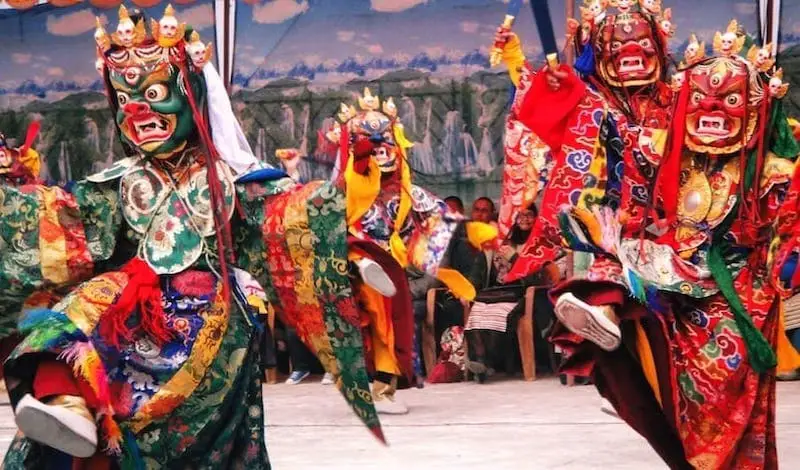If you have ever been to Nepal, then you know how all the festivals in Nepal bring the country to life. With celebrations so big they shut down the country as everyone heads back to their village to celebrate.
Dashain and Tihar are the biggest Nepali festivals, but what you may not have known is about the countless other festivals in Nepal that are celebrated throughout the Himalayan country. Many celebrations are tied to religion (Hinduism or Buddhism) and culture, and that is one reason why looking at the Kathmandu valley is so fascinating.
Whereas, Kathmandu, with its prolific Newari culture and heritage, has a distinct set of holidays and unique festivities that take place. Now, you may not be lucky enough to spend an entire year in Nepal, to celebrate some of the bigger holidays. However, lucky for tourists, Nepal has over 30 public holidays, as well as many other smaller celebrations throughout the year. This means you have a great chance of being able to partake in the festivities in Nepal.
Festivals in Nepal:
This blog focuses on 40 different Nepali festivals in Kathmandu that you can watch if you are traveling in the capital city. Each of these festivals are broken down into their respective English months (Gregorian calendar) – make sure to check the Nepali calendar (Nepali Patro) for the exact days. As the Nepali calendar changes every year.
Let’s jump right into it and take a look at the different festivals throughout the year.
January Nepali Festivals:
1. Gyo Chaku Sanlhu or Maghe Sankranti
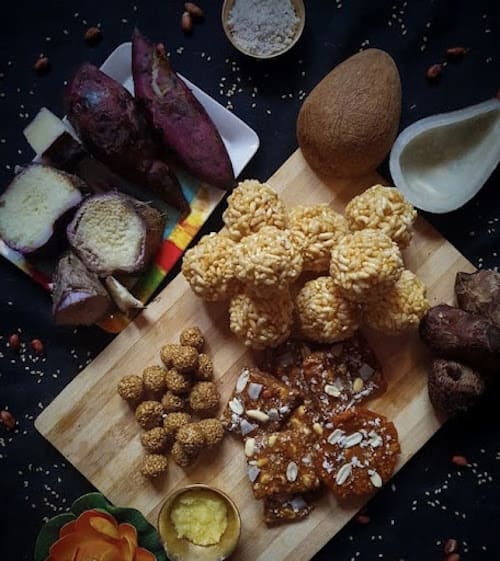
Gyo Chaku Sanlhu or Maghe Sankranti, is a festival in Nepal that is celebrated on the first day of the month of Magh. The day marks the end of the winter solstice. Additionally, the Tharu community also celebrates this particular day as their new year. It is also an important day for the Magar community, who hold large gatherings with friends and family. Additionally, during the Maghe Sankranti festival, the Magar community, also dresses in traditional Dhaka clothing and fabric.
The festival is celebrated with dancing and singing, as well as eating a specific meal with Ghee (Clarified butter), Chaku (Sugarcane molasse), ladoos (sesame balls) and Yams. Additionally, people celebrate by also receiving tika from their elders.
2. Shree Panchami
The Nepal festival of Shree Panchami worships the Goddess of Saraswati who is the goddess of wisdom, knowledge, skills and performance. People celebrate the auspicious day by wearing yellow, or white, eating sweets, and displaying yellow flowers around their homes and temples. Additionally, Shree Panchami is important for newly wed couples as they visit the temples and offer prayers and respect to the Goddess on the first Shree Panchami after their marriage.
February Nepali Festivals:
3. Maha Shiva Ratri
Maha Shiva Ratri, or Shive Ratri for short, is celebrated by Hindus as an annual festival to honor Lord Shiva. The festival in Nepal is celebrated throughout the country, and is to welcome the arrival of spring, as well as pay homage to when Lord Shiva performed the heavenly dance called Tandava. The day is also in connection with overcoming darkness and ignorance in life and the world. People meditate, chant prayers, fast and contemplate ethics and virtues such as honesty, not injuring other, charity and forgiveness.
Kids also celebrate the festival by setting up small roadblocks to stop people from walking to collect small alms for their bonfires at night time.
The major location for celebration is Pashupatinath, where thousands of devotees will gather and practice prayers and pay their respects to Shiva.
4. Samyak Mahadan
Samyak Mahadan is a Newari festival in Nepal which is conducted once every five years in Patan. It is a Buddhist celebration where Newaris give alms to different idols of Dipankara Buddha (one of the main Buddhas of the past). For the celebration, hundreds of the idols are gathered and placed in Nagbahal for worship.
The festival is also celebrated in Kathmandu, however that event only occurs every 12 years. Finally, in Bhaktapur, it is celebrated every year. With the first Samyak Mahadan taking place in Nepal Sambat 135 (1015 AD).
March Nepali Festivals:
5. Falgu Purnima or Holi
Falgu Purnima or Holi the Festival of Colors is celebrated throughout Nepal during March (sometimes February). It is conducted to welcome spring, as well as to symbolize the triumph of good over evil. Whereas, legend states that Holika who is the sister of demon king Hiranyakashyap tried to kill her brother’s young son Prahlad. However, Prohald was able to protect himself by chanting Narayan’s name, who protected him and vanquished Holika.
The festival today is now a joyous time with colors being thrown at people, water and water balloons being used to soak people, and a great deal of dancing and singing.
6. Ghode Jatra
Ghode Jatra or ‘horse parade’ in English, is celebrated in Tundikel, Kathmandu every year. The event is now a very formal festival that takes place in front of the Prime Minister and President of Nepal, with personnel from the Nepali Army riding horses. The actual celebration is to honor the victory over demons and to keep evil spirits away for the year to come.
Newaris also celebrate the festival by carrying deities including the Goddess Bhadrakali and Kankeshwari throughout the streets of Asan.
7. Beginning of Bunga Dyo Jatra or Rato Machindranath
The Bunga Dyo Jatra festival is the biggest and longest chariot festival of Nepal. The festivities are celebrated by Hindus and Buddhists and lasts for an entire month. With the beginning of the festival the devotees begin building the tall, large chariot to be pulled from place to place in Lalitpur. During the month of March, travelers and tourists can see the chariot pulled by hundreds of people up and down the streets.
April Nepali Festivals:
8. Paykhaa Jatra
Payakhaa Jatra marks the first day of a three day long jatra or procession of the idols of Lord Ganesh, Kumar, Balkumari, and Bhringareshowr Mahadev (Shiva). The jatra is celebrated in Sunakothi, a rural farmer village located on the southside of Patan in Lalitpur.
9. Mayagu Khwa Swayegu Din or Mother’s Day in Nepal
Nepali mothers day or Amma ko mukh herna din (translates to see your mothers face) is an auspicious day in Nepali culture where daughters and sons from around the country come back home to see their mother and give gifts and sweets. If the person’s mother has passed away, they go to nearby temples to pay their respects and offer up prayers.
May Nepali Festivals:
10. Buddha Jayanti:
Buddha Jayanti is an important Nepali festival as it celebrates the birthday of the Lord Buddha. As Patan is composed of more that 40% Buddhists and the Buddha was born in Nepal, it is an extremely auspicious day for communities in the Patan and the Kathmandu Valley.
Recommend Reading: Quotes from Buddha to live a better life!
11. Sithi Nakha:
The Sithi Nakha is celebrated and dedicated to Lord Kumar Kartikeya, who is the eldest son of Lord Shiva. The festival marks the beginning of the monsoon season, and the community engages in cleaning the water sources around them, such as ponds, wells, and stone spouts. Moreover, traditional Newari dishes are made in respect to their ancestral gods. Some of the dishes include: traditional pancakes like dishes such as Bara and Chatamari.
June Nepali Festivals:
12. Bhoto Jatra
This is the final event of the month-long Chariot festival known as Rato Machhendranath Jatra of Bungdyo. After the jatra procession ends, an ornamented bhoto (vest) is shown to everyone in the crowd. It is believed that everyone that sees the ornamented vest will have good luck for the year to come.
The community believes that the boto (vest) was given to a farmer out of gratitude by the Kartotake Nag, for curing the eye ailment of his queen. The farmer proceeded to cherish the boto, until one day, it was stolen by a ghost. As the ghost ran away with the diamond encrusted vest, the farmer followed it, and they both found themselves in the crowd of the Rato Machhendranath Jatra. The king was also in attendance and found the two fighting over the vest. The king was not sure who the vest belonged to and being a fair and just King, allowed them to show him evidence of true ownership. However, the king stated that until proof could be shown the vest would stay with the chariot.
Until this day, neither the farmer nor the ghost could show any proof of true ownership!
July Nepali Festivals:
13. Gathamuga Cahre or Ghanta Karna
Gathamuga Cahre or Ghanta Karna is a famous Newari festival that celebrates the defeat of the demon Ghanta-Karna. The story goes that the demon wore large bell earrings which were used to drown out the name of God Shiva, with the jingling. The reason the defeat is so important is that the demon was attributed to negative acts such as robbery, morder, and kidnapping of children. Newaris will celebrate the festival by placing burning hay men who supposedly resemble Gathamuga at various crossroads in the city.
14. Nagdaha Mela or Nagpanchami
A huge mela is organized at Nagdaha, believed to be the dwelling of Champak Naag, situated in Dhapakhel of lalitpur. People of the Kathmandu Valley come to pay their respect and worship the serpent god by offering dubo (Bermuda grass), milk, ghee (clarified butter, paste of rice grains and red vermilion powder. The festival is significant as it is believed that by worshiping snakes, they will be able to avoid bad omens throughout the year. Also as snakes are considered to be water guardians, devotees must pay respect to the snakes in order to ensure regular rainfall for the upcoming agriculture season. offering. Finally, to pay respect, people post pictures of snakes containing various mantras above the entrance to their houses.
It is a festival to mark respect to serpents as the water guardians, and to ensure regular rainfall in the Kathmandu Valley.
15. Pancha Daan
Pancha Daan is the festival for the five summer gifts. Whereas, the gifts include: rice grains, unhusked rice grains, salt, money and various pulses which are important to the daily life of a person. The festival symbolizes the importance of remembering and practicing Buddha’s dana shila, which are two of the six moralities taught by Buddha. Moreover, on this day, you will be able to see sacred family artifacts in front of monasteries and households.
August Nepali Festivals:
16. Janai Purnima or Rakshya Bandhan
Newars of the Kathmandu Valley celebrate this festival in the inter city and call it Gunhi Punhi, which translates to mean the 9th full moon of the year. To celebrate the festival, Brahmin priests provide prayers while they tie yellow sacred threads around the wrists of the faithful, or around the torso of a person from the Brahmin or Chetri lineage. Moreover, in terms of food, a soup made out of nine different legumes is prepared during the day and consumed by the family members of the household.
17. Gai Jatra
Gai Jatra is translated to The festival of cows, and is one of the most popular festivals in Kathmandu as well as Nepal. The festival gained popularity when, long ago the festival was shown to the Queen at the time who ended up loving it. After her fascination with the festival, it became a yearly and widespread event.
However, the main festival is conducted as they believe on the auspicious days, the gates of heaven open up, and by parading around the city, they can help their beloved to reach the gates of heaven. The festival is not only celebrated for the deceased family members, but also for the promotion of peace and harmony amongst family members. The people marching around the city for the festival, dress up as different forms of gods and goddesses.
18. Matya Jatra
The festival Matya Jatra is also known as the Festival of Light. It is a traditional Newari festival that has families that have lost members of their family in the past year walk through different Buddhist stupas and other Hindu temples as a remembrance. During the procession the people involved are typically dressed in traditional Newari clothing, play music and hold candles and torches.
Curious about other traditional dresses in Nepal? Have a look at our blog covering traditional dresses that you would love to wear!
19. Krishna Janmastami
Krishna Janmastami marks the birth of the god Krishna, who is the eighth avatar of Vishnu. In oder to experience this festival in Nepal, you will have to visit Krishna Mandir (Temple) in Patan Durbar Square is a major gathering place. Once at the temple the festivities include fasting, singing, engaging in prayer together, sharing of Krishna’s favorite foods, and night vigils.
20. Bhimsen Chariot Jatra:
Bhimsen Jatra is observed on the ninth day of the lunar dark fortnight in Bhadra – usually late August or early September. The festivities begin with the local priest bringing down the statue of the Lord Bhimsen from the Magal Bazaar temple in Patan, and then fixes it in the chariot to be paraded around town.
The Newari community observes the celebration by taking the statue and chariot around town, accompanied by songs and traditional Newari songs. Moreover, people also carry the chariot with a great deal of incense sticks in order to worship Lord Bhimsen as they pass through Patan Durbar Square. People worship Lord Bhimsen as he is the god of commerce, industry & fortunes.
21. Gunla
Gunla is celebrated over an entire month and is primarily celebrated by Newari Buddhists. The Newari Buddhists typically recite various scriptures, practice fasting, play religious music, and visit temples of worship. People celebrating Gunla in Kathmandu typically make early morning pilgrimages to Swayambhu, or other auspicious buddhist temples in the Kathmandu Valley.
22. Teej Festival
Teej is the biggest festival for Hindu women in Nepal, encompassing a multiple day festival. The Teej festival is observed by women and girls and dedicated to the Goddess Parvati in remembrance of her union with Lord Shiva. The festival is celebrated through songs, dancing, prayer rituals, and fasting. Fasting is usually performed by women as it is believed that it will ensure a long and healthy life for their husbands.
23. Chatha or Ganesh Chaturthi
The festival is celebrated in order to welcome the arrival of Ganesh to Earth accompanied by his mother, Goddess Parvati. To pay respect to Ganesh, his statue is placed around the house and at other auspicious places in the area. Moreover, throughout the day, respect is also given to Ganesh by chanting various Vedic Hymns and Hindu texts.
24. Rishi Panchami
On the fifth and last day of the Teej festival, the women pay their respect and gratitude to the great deeds of the Rishis (defining an accomplished and enlightened person) before them. Moreover, these Rishis are well known for helping the welfare of others and the society in general. To pay their respects, women engage in a full body and soul cleansing ritual in the morning and then by fasting for the rest of the day.
September Nepali Festivals:
25. Indra Jatra or Yenya
Indra Jatra also known as Yenyā in Newari Language, is celebrated for five days as part of the largest street festival in Kathmandu and consists of the Indra Jatra as well as the Kumari Jatra. Throughout the jatras there are masked dances of deities and demons to pay homage to the king of heaven, Indra who also represents rain and good harvest. Moreover, the Kumari Jatra also is performed which consists of the living goddess Kumari, being carried around on a chariot procession.
One reason for the festival is to pay respect to the family members that have been lost throughout the year. Historically, another reason is to promote unity among the various communities in Kathmandu.
26. Purnachandi Bhuja Jatra
The Purnachandi Bhuja Jatra festivities are famous for the 12 large heaps of rice that contain 160 pounds each. The mounds are then shaped into stupa or temples. Moreover the rice is decorated and adorned with 84 different traditional Newari dishes. It is believed that the offerings will protect Patan from lightning.
Interestingly enough, there are relatively no reports of lightning around the temple where the ritual is performed. The priest of the temple is quick to remark that this is because of the rituals and offerings given.
Want to see some other weird facts about rice in Nepal? Check out our blog talking about Nepal’s love for rice – crazy uses of rice in Nepal.
October Nepali Festivals:
27. Sikali Jatra or Khokana Jatra:
In Khokana, a Newari village in the southern part of the Kathmandu Valley, the residents celebrate the Sikali Jatra for five days instead of the Dashain Festival. The five day festival is dedicated to the Goddess Shikali (also known as Ajima) who is the Mother Goddess.
The festival begins with the Goddess Rudrayani being carried throughout the village towards the temple on a wooden chariot. During the procession the ritual is accompanied by the masked dancers who represent the 14 gods and goddesses of the Hindu Pantheon.
28. Nalaswanegu Din or Ghatasthapana
It marks the beginning of Mohanni (or Dashain in Nepali), the biggest festival of Nepal, celebrated by Hindus and Buddhists. During the first day of worship, Nepalis pay their respects to the Goddess Durga by placing a kalash (holy water vessel) into the prayer room. The vessel is also covered with cow dung with seeds (jamara seeds) spread over it which will grow in around ten days. Additionally, the festivities are marked by a priest issuing prayers and asking the Goddess Durga to bless the Kalash and stay with it for the next 10 days.
29. Phoolpati
The fifth day of Mohani celebrates Phoolpati with the auspicious event of walking a vessel full of flowers from Gorkha all the way to Kathmandu. The flowers are then presented to the President of Nepal (historically, the flowers were presented to the King and the royal family, however after the Royal Massacre of Nepal, and the monarchy being abolished, the president has taken over the role.)
For the typical Nepali family however, the day is celebrated by bringing nine different types of flowers into the Puja (worship) room. The nine different plants include:
- Banana plant (kera ko bot): Representing the Goddess Brahmani – who bestows peace.
- Pomegranate (darim): Representing the Goddess Rakta Dantika – who helps and blesses the worshiper
- Rice stalk (dhanko bala) – Representing the Goddess Lakshmi – who bestows wealth
- Turmeric plant (haledo) – Representing the Goddess Durga – puts an end to obstacles
- Manabriksha: Representing the Goddess Chamunda – who puts an end to evil
- Ginger plant (अदुवा) – Representing the Goddess Kalika – who blesses mankind
- Apple tree (bel plant) – Representing Lord Shiva – Favorite fruit of Lord Vishnu and Shiva
- Ashok plant – Represents the Goddess Sokarahita
- Jayanti – Which represents the Goddess Kartiki
30. Maha Ashtami
Maha Ashtami is the eighth day of Vijayadashami and celebrates Durga Bhawani and Kali Mata (different names and incarnations). Worship and respect is paid to Durga and Kali by performing animal sacrifices. During the day, Hindu devotees also practice fasting. However, at night time a completely different scenario is witnessed. Whereas, the night of Ashtami also known as ‘Kal Rari’ (The dark night), countless numbers of goats, sheeps buffalos are sacrificed at Kali’s temples and households. The sacrifices continue well into the night, and the following day feasts are held in many locations and households.
31. Maha Navami
Ninety day of mohani is marked by worshiping Durga or Taleju Bhwani. Whereas, the Goddess Durga is celebrated for slaying Mahishasura the Buffalo Demon. The festivities for this celebration start in the morning where in Patan Durbar Square, at Taleju temple, 21 buffalos are sacrificed. There have been many rituals throughout time to celebrate the auspicious day. However, the most unique ritual is conducted at the Subahal. Which, Nepalis believe in ancient times, used to be the location of human sacrifices.
32. Vijaya Dashami – Dussahra, Dasara, or Dashain
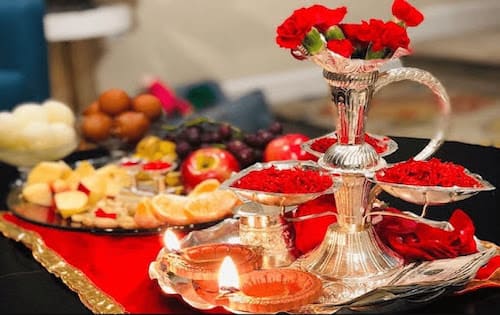
One of the biggest festivals of the year, the Hindu festival is celebrated on the tenth day of the Hindu calendar or Ashvin. During the festival time, people from around Nepal return to their villages and hometowns, to pay respect to their elders. Whereas, the elders will provide the visitors with tika (rice grains mixed with crimson powder), and give them various blessings for success, prosperity and a long life. Additionally, the visitors are typically given a variety of traditional Nepali foods, and a small amount of money.
33. Aju/Aji Manakamana Jatra
Bungamati located in Lalitpur in the Kathmandu Valley is home of the Goddess Manakamana. Instead of celebrating the tenth day of Dashain and the placing of tika on foreheads, the people living in Bungamati celebrate with the Bhairav Jatra instead. Whereas during the jatra the Hanuman Jagaune ritual begins with the spirit Hanuman being evoked into choosing a person and taking them. After this, the pair of Bhairava idols also known as Aaju & Aji are placed into a palanquin and carried around the Bungamati area on a specific route. The festival is conducted to pay respect to the ancient folk-story of where Bhairava and Bhimsen contest each other’s power following an intense argument.
34. Payaa Piha Woigu or Khadga Jatra
It is celebrated by the Newari community of Kathmandu. The Paya is regarded as a victory procession, which celebrates the triumph of good over evil. Moreover, the good over evil tale follows the legend of the victory of Goddess Durga over Mahishasura, the demon. As part of the festival, the sword used in the battle is worshiped and paraded around the city. The procession of the sword and its worshippers starts from the Taleju goddess temple and marches to Tallo Lachhi.
November Nepali Festivals:
35. Ko Puja or Kaag Tihar

Ko Puja or Kaag (crow) Tihar marks the beginning of Tihar. The first day of Tihar is devoted to crows and ravens. Whereas, crows and ravens are believed to be the messengers of Yama, the god of death. Therefore, to appease the god, people offer up grains, seeds and other foods to the crows and ravens. This is extremely important to Hindus, as the cawing of these birds are believed to carry messages from Yama. And by feeding the birds, people hope to please Yama, and stop the messages of death coming.
36. Khicha Puja or Kukur Tihar
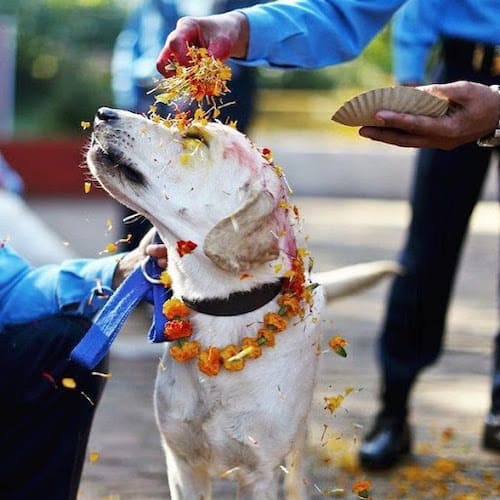
The second day of Tihar is known as Khicha Puja (Newari language) or Kukar (dog) Tihar. On this auspicious festival day in Nepal, dogs, no matter if they are strays or pets, or given tika, garlands made of marigolds as well as treats. One reason for the worshiping of dogs is that at the gates of heaven, Yudhishthira refused to enter without the dog as it accompanied him along the journey to heaven high in the Himalayas. And, when he was asked to abandon the dog, Yudhishthira, claimed that dog was extremely loyal and would not abandon it. Thus, at heaven’s gates the ancient bond between man and dog is established in the Mahabharata.
37. Gai Tihar or Laxmi Puja

Laxmi Puja is one of the most important days of the five day long Tihar festival. It is celebrated on the third day of Sunti with people worshiping the goddess of wealth and prosperity, Laxmi. Additionally, In the morning of Laxmi Puja, people worship their cows by offering special alms. One important reason for this is that cows resemble mothers as well as the Goddess Laxmi herself.
38. Govardhan Puja and Mha Puja
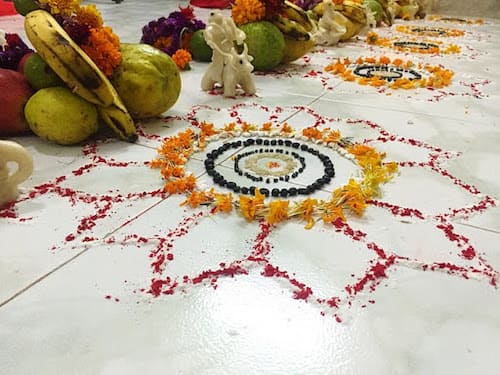
The fourth day of Tihar is Govardhan Puja and Mha Puja which translates to worship of the hillock made from cow dung and worship of the inner self. Additionally, the day also marks the new year for the Newar Calendar. Newaris celebrate the day by worshiping their own bodies in a family ritual setting. This is done by cleansing their body and conducting puja (worship), followed by treating themselves to a feast which consists of auspicious food items including: rice wine, meat, smoked fish, lentil cake and boiled egg. These food items represent Tantric concepts.
39. Bhai Tika or Kija Puja

Kija Puja is the last day of the five day Sonti. During Kija Puja or Bhai tika, younger brothers are celebrated by their sisters. The sisters will offer up prayers for their younger brothers to live long and prosperous lives. The auspicious day is then celebrated by the sisters of the family providing an array of food items to their younger brothers and the brothers then reciprocate the affection by giving gifts to their older sisters.
December Nepali Festivals:
40. Yomari Punhi
Yomari Punhi is a Newari festival marking the end of the rice harvest. People of the Kathmandu Valley worship Annapurna, the Goddess of Grains, for the rice harvest on the day of the full moon. Yomari is a delicacy and it is eaten while the jatra is celebrated at Harisiddhi, Lalitpur. Additionally, during the evening, groups of kids will roam around the neighborhood to beg for Yomari from different houses. There are also sacred masked dances that are performed and seen by visitors in the villages of Hari Siddhi and Thecho – located at the southern end of the Kathmandu Valley.
Want to learn more about Yomari? Check out my blog that covers the story and recipe of Yomari!
Key Takeaways: Festivals in Nepal
Nepal is a culturally rich and diverse country giving rise to over 30 public holidays during the year. Each festival is unique and offers an exciting look at how the country has evolved. Moreover, with religion in Nepal being so diverse, there are countless other smaller religious events in the distant parts of the country.
Of course Dashain and Tihar are the most well known celebrations during the year, however, if you get a chance, make sure to check one of the other major festivals in Nepal during your stay. You wont regret it!
